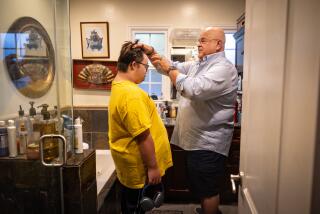An After-School Gap Seen for Teens
- Share via
It is 4 p.m. on a recent afternoon and, after a long day at school, 14-year-old Ben Falealili could be at home napping, watching television or hanging out interminably with his buddies.
Instead, he is in a Long Beach after-school program, strumming a guitar he is learning to play and imagining -- via the program’s digital video equipment -- a bright future as a filmmaker or actor.
“It’s cool to have something like this to come to,” Ben said, referring to the CORAL Long Beach Youth Institute, where he spends about 12 hours a week. “At school, there’s sports and some clubs, but otherwise not really much to do after school.”
Ben, a freshman at Long Beach Polytechnic High School, is one of the lucky students, according to a report being released today by the law enforcement group Fight Crime: Invest in Kids California.
The report contends that California shortchanges high school students in favor of elementary and middle school students when it comes to funding after-school programs. The state parcels out only about 6% to 8% of its federal after-school funds to programs for high-schoolers, according to the study.
This, despite evidence that high school students are more likely to commit crimes and abuse drugs than their younger counterparts.
The discrepancy, the report notes, is likely to widen with Proposition 49, the measure sponsored by Arnold Schwarzenegger before he became governor and approved by voters in 2002. If the economy improves, the measure would add up to $550 million a year in state general funds for after-school programs at elementary and middle schools.
Yet the demand for teen after-school programs is high: In 2002, there was enough funding for only one in eight such programs that applied, according to the report, titled “California’s Next After-School Challenge: Keeping High School Teens Off the Streets and on the Right Track.”
In addition, the report states that many California schools fail to use their own resources: Within an hour of school letting out, 65% of high schools in the state’s poorest neighborhoods close their computer labs, 73% close libraries and 84% close gyms.
The report’s author, Brian Lee, said lower grades get more funding because parents and educators worry about younger children left at home alone.
“That concern is justifiable, but people forget that teens are also being left unsupervised,” said Lee. “Four out of five juvenile crimes are committed by high school kids, and they are involved in drug and alcohol use at a much greater magnitude.”
The main source of after-school funds available for California high schools is a federal block grant called the 21st Century Program. The state Legislature determines how to divvy up that grant. In 2003, $120 million went to elementary and middle school programs and about $8 million to $10 million went to high schools, according to the report.
As a result, 3% of California high schools -- 66 out of 2,266 -- received federal after-school funding, according to the report.
The Los Angeles Unified School District received a five-year, $40-million federal grant last year, but all of the money was awarded to elementary and middle schools, said John Liechty, associate superintendent of extended day programs.
“I think there’s a belief that high school students have a greater number of everyday activities like athletic teams or band, but we could use after-school programs on every one of our high school campuses,” said Liechty. Local districts and private grants fund some after-school programs, but the report indicates that, again, younger children mainly benefit.
And the programs that do cater to high school youths, such as the CORAL Long Beach Youth Institute, funded by a grant from the James Irvine Foundation, can have long waiting lists. Last year, 220 youths applied for 40 open spots, said its director, Robert Cabeza.
Hilary McLean, a spokeswoman for the state superintendent of public instruction, said state education officials “believe that high school after-school programs work and we would like to see them get their fair share of funding.” A state bill -- SB481 -- would guarantee that high school programs receive at least 6% of federal after-school funds. It recently passed the state Senate and is pending in the Assembly.
“These programs can give high school kids a reason to continue going to school and get them enthused about projects,” said Lee Angela Reid, senior policy advisor and education consultant to state Sen. Bruce McPherson (R-Santa Cruz), who is carrying the bill.
The CORAL program offers ninth- through 12th-graders summer activities to develop academic and job skills and after-school projects such as tutoring grade-school students, using computers to create websites, making movies and learning music. The students get an $800 summer stipend and can earn money as tutors.
Asia McKinney, 15, a sophomore at Millikan High School, spent a recent afternoon in the program’s bustling headquarters -- rented rooms at St. Luke’s Church -- editing digital photographs taken during a group trip to San Francisco, where students met with people from Apple Computer Inc. Ben Falealili said his grades and attitude have improved since he joined the program.
“I used to joke around and be a smart-mouth,” he said. “But as the program has gone on, I’ve become more mature, which has really helped me out.”
More to Read
Get the L.A. Times Politics newsletter
Deeply reported insights into legislation, politics and policy from Sacramento, Washington and beyond. In your inbox twice per week.
You may occasionally receive promotional content from the Los Angeles Times.











